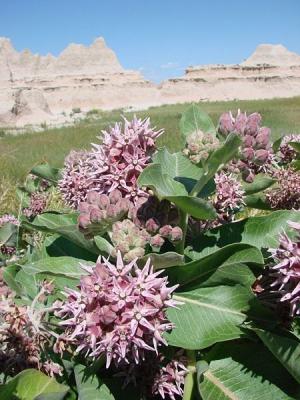Milkweed

Asclepias, the milkweeds, are a genus of perennial flowering herbs comprised of over 140 known species. Milkweeds are found throughout the United States in either dry or swampy open areas with good exposure to the sun. Milkweed is known and so named for the milky white sap it produces and exudes in response to injury such as when stems are broken or a leaf removed. Depending upon the species the plant may be narrow-leafed (whorled) or broad-leafed; the narrow-leafed variety is considered to be the most toxic. The flowers are in umbels, greenish white to purple with five sepals and petals which are strongly reflexed. From the base of each pedal a club-shaped or hooded lobe extends upwards. The fruit is a follicle, with numerous seeds, each with a tuft of silky hairs that aids spread of seeds by the wind.
All parts of the plant should be considered extremely toxic, whether dry or fresh. Therefore, contaminated hay that may have inadvertently had wild growing milkweed bundled in could potentially be toxic. The toxic and lethal consumption amounts are nearly identical. The highest levels of toxins typically occur in the milky sap, which can be found throughout the entirety of the plant. The roots have the lowest concentration of toxins. The sap contains alkaloids, latex, and several other complex compounds including cardenolides. The sap contains about 1 to 2% latex, as a result there is the possibility of contact dermatitis to the mouth, throat, nose and face in animals with sensitive skin or allergies to latex. Some species of milkweed also produce proteinases in their latex. One such proteinase is asclepain which is chemically similar to papain and bromelain. Both of which are known to be cardiotoxic.
Found in all vegetative parts of the plant, the primary toxic principle, galitoxin, a resinous substance is thought to be responsible for symptoms common in cases of milkweed poisoning such as weakness, spasms, and seizures. In addition to galitoxin milkweed contains cardiac glycosides that may be responsible for the digitalis-like signs of intoxication that often cause or contribute to death. These glycosides cause electrolyte imbalances in heart muscle, resulting in arrhythmias and cardiac failure. In general, it appears that the broad-leaved species produce cardiotoxic and GI effects while the narrow-leaved species are more commonly neurotoxic. Cattle have died from consuming as little as 0.05% of the body weight and sheep have suffered lethal consequences with the ingestion of as little as 1 to 2 ounces of green leaf material.Death will typically occur from 1-3 days after ingestion of lethal amount of plant material.
Treatment for the ingestion of milkweed is going to be symptomatic and supportive as there is no specific antidote. In the event the animal is witnessed eating the plant or identifiable plant matter is found in the mouth remove any existing plant matter from the mouth and flush the mouth thoroughly with water. In dogs and cats, if it is believed that the animal may have the plant recently, vomiting may be induced. This can be accomplished using an emetic such as 3% hydrogen peroxide at dosage of 1 teaspoon per 10 lbs of body weight. Although not practical in the home or a field setting, gastric lavage commonly called stomach pumping or gastric irrigation should also be given consideration as a treatment option. Activated medical charcoal (2-5 g/kg body weight) may also aid in preventing further absorption of the toxins by the body.
The cardiac glycoside galitoxin produces digitalis-like signs of intoxication that often cause or contribute to death. As a result, the toxic effects may, in severe cases, include various arrhythmias as well as inhibition of cardiac conduction and function. If the animal is beginning to suffer cardiac abnormalities it may be necessary to administer drugs such as potassium chloride, procainamide, lidocaine, dipotassium EDTA, or atropine sulfate. Atropine is the most widely used agent in treating bradycardia. Accelerating the heart rate with atropine or other beta-adrenergic agents theoretically increases the risk of tachyarrhythmias; which have a poorer prognosis and are more difficult to treat. Some have claimed that atropine increases tachyarrhythmic deaths, although further studies are required to confirm this. Lidocaine is often the preferred antiarrhythmic. Additionally monitoring kidney function is essential and close scrutiny needs to be placed on monitoring the cardiac activity for arrhythmias.
One of the most common causes of intoxication is milkweed plant material as a contaminant in hay; as a result hay should be examined before feeding and discarded if milkweed is present. As the non palatability of the plant leads to very few poisonings, documentation regarding a specific treatment regimen is sparse. Prevent further ingestion of the plant and consult your veterinarian.
The prognosis for animals that have ingested milkweed is going to depend on the amount that was ingested, and the time that has elapsed since the ingestion. In general, for animals that have ingested a large amount (if not detected very early) the prognosis is poor to grave. For animals that may have ingested a small to moderate amount, or in cases where the ingestion was detected early and treatment was administered, the prognosis can range from good to guarded. Prevent further ingestion of the plant and seek veterinary care.




